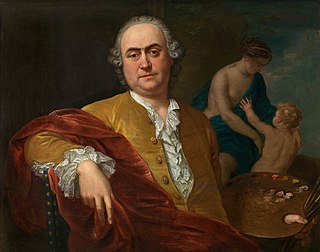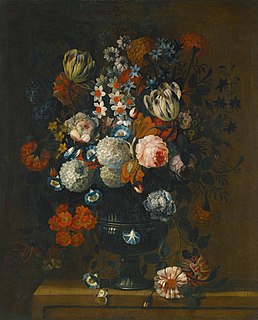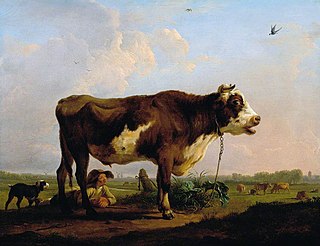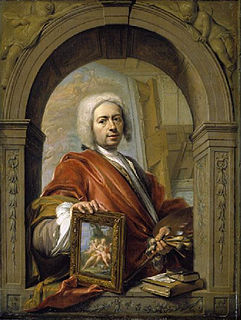 W
WAugustin van den Berghe, was an 18th-century painter from the Southern Netherlands.
 W
WBalthasar Beschey was a Flemish painter, draughtsman and decorative painter of interiors. He started his career as landscape painter but later on switched to history and portrait painting. He played a prominent role in the development of the Academy of Arts in Antwerp and as a teacher.
 W
WFrans Breydel or Frans Breydel I was a Flemish painter, draftsman and decorative painter. He is known for his merry companies, carnival scenes, landscapes and battle pieces.
 W
WKarel Breydel or Carel Breydel, called 'Le Chevalier' was a Flemish painter of battle pieces, equestrian paintings and landscapes.
 W
WPieter Casteels III (1684–1749) was a Flemish painter and engraver mainly known for his flower pieces, game pieces and bird scenes. He spent a significant portion of his life in England where he had a varied career as a still life painter, printmaker and textile designer.
 W
WHendrik de Cort or Hendrik Frans de Cort was a Flemish landscape painter and draughtsman. His international career brought him to Antwerp, Paris, England and Wales. He is mainly remembered for his topographical paintings and drawings of English castles, country houses, parks and ruins.
 W
WJan Frans van Dael or Jean-François van Dael was a Flemish painter and lithographer specializing in still lifes of flowers and fruit. He had a successful career in Paris where his patrons included the Empresses of Empire France as well as the kings of Restoration France.
 W
WJean-Bernard Duvivier was a painter and drawer of portraits and historical and religious subjects, a book illustrator and a professor at the Normal School in Paris. After having been instructed by Hubert and Paul de Cock and Suvée, he studied in Italy for six years. His style is characterised by balanced composition, lifelike drawing and bright colours.
 W
WJan Frans Eliaerts was a Flemish painter of animals, flowers, and fruit who migrated to France where he was active most of his life.
 W
WPieter Faes or Peeter Faes was a Flemish painter of still lifes of flowers and fruit. He worked in a decorative style close to that of Jan van Huysum.
 W
WCarel van Falens was a Flemish painter, draughtsman, copyist, art restorer, art dealer and copyist. He specialised in scenes of hunters and cavalry encampments in the popular style of the Dutch battle and horse painter Philips Wouwerman. He worked most of his life in France where he was a painter to the court and a member of the Académie royale.
 W
WJan Anton Garemyn (1712-1799), a Flemish painter and engraver, was born at Bruges, and studied under Louis Boons and Matthias de Visch. He painted numerous altar-pieces for the churches at Bruges and Courtrai; and others for private persons at Brussels and Ghent. His pictures are highly esteemed by his countrymen for their warmth of colouring. He painted several pictures in imitation of Rembrandt and Teniers, and designed and executed several of the plates for the Chronyke van Vlaenderen, published in 1736. He became professor in the Academy of Bruges, and died in that city in 1799.
 W
WJohann Georg de Hamilton, was an 18th-century painter from the Southern Netherlands active in Austria.
 W
WPhilipp Ferdinand de Hamilton, was an 18th-century painter from the Southern Netherlands active in Austria.
 W
WPieter Hardimé was a Flemish painter known for his paintings of flowers. He trained in Antwerp and later moved to the Dutch Republic where he worked in The Hague. He was active as a decorative painter of flowers for wall and ceiling decorations, often in collaboration with Mattheus Terwesten.
 W
WSimon Hardimé (1672–1737) was a Flemish painter of mixed Walloon and Flemish descent. He is known for his paintings of flowers. He trained in Antwerp and later worked for a few years in the Dutch Republic. He then moved to London where he remained the rest of his life. His patrons included the bourgeoisie in Brussels and Antwerp and aristocrats in the Netherlands and England.
 W
WZeger Jacob van Helmont, was a Flemish painter and tapestry designer who specialized in portraits and history paintings. He trained with his father in Antwerp but spent his active career in Brussels where he worked for the local churches and tapestry works.
 W
WWillem Jacob Herreyns was a Flemish painter of history subjects and portraits. He is regarded as one of the last painters in the tradition of the Flemish Baroque and the last follower of Peter Paul Rubens.
 W
WJan Josef Horemans the Elder (1682–1759) was a Flemish painter of the 18th-century. He was mainly known for his genre scenes but he also painted portraits and historical allegories.
 W
WJan Josef Horemans the Younger was an 18th-century Flemish painter. He is mainly known for his genre scenes but also painted harbor views, equestrian paintings, portraits and still lifes.
 W
WVictor Honorius Janssens or Victor Honoré Janssens was a Flemish painter of religious and mythological works and a tapestry designer. He spent a substantial period of his career abroad and worked in Germany, Italy, Vienna and London. He was court painter of Emperor Charles VI of Austria in Vienna. He is mainly known for his mythological and history paintings.
 W
WJan Baptist Lambrechts was an 18th-century Flemish painter. He is mainly known for his genre scenes of drinkers, cooks, maids, vegetable salesmen and dancing farmers.
 W
WHendrik Frans van Lint was a Flemish landscape and vedute painter who was part of the group of Flemish and Dutch painters active in Rome. He was one of the leading landscape painters in Rome in the first half of the 18th century and his patrons included Rome's old aristocratic families as well as European travellers on their Grand Tour.
 W
WJan Baptist Monteyne or J.B. Monteyne was an 18th-century Flemish painter. He is mainly known for his genre scenes and landscapes.
 W
WBalthasar Paul Ommeganck (1755–1826) was a Flemish painter of landscapes and animals active in Antwerp. Through his work and his role as an art teacher and founder of art institutions he gave an important impetus to the revitalization of landscape painting in the Low Countries.
 W
WJoseph Paelinck, was a painter from the Southern Netherlands.
 W
WJacques Ignatius de Roore or Jacobus Ignatius de Roore was a Flemish painter, copyist, art dealer and art collector who worked in the Southern Netherlands and the Dutch Republic.
 W
WJoseph-Benoît Suvée was a Flemish painter strongly influenced by French neo-classicism.
 W
WHenri Van Assche (1774–1841) was a Belgian painter.
 W
WJean Baptiste Vanmour or Van Mour was a Flemish-French painter, remembered for his detailed portrayal of life in the Ottoman Empire during the Tulip Era and the rule of Sultan Ahmed III.
 W
WMatthias de Visch or Matthijs de Visch was a Flemish painter of history paintings and portraits.
 W
WGeorges Frédéric Ziesel, was a Flemish flower and still life painter.